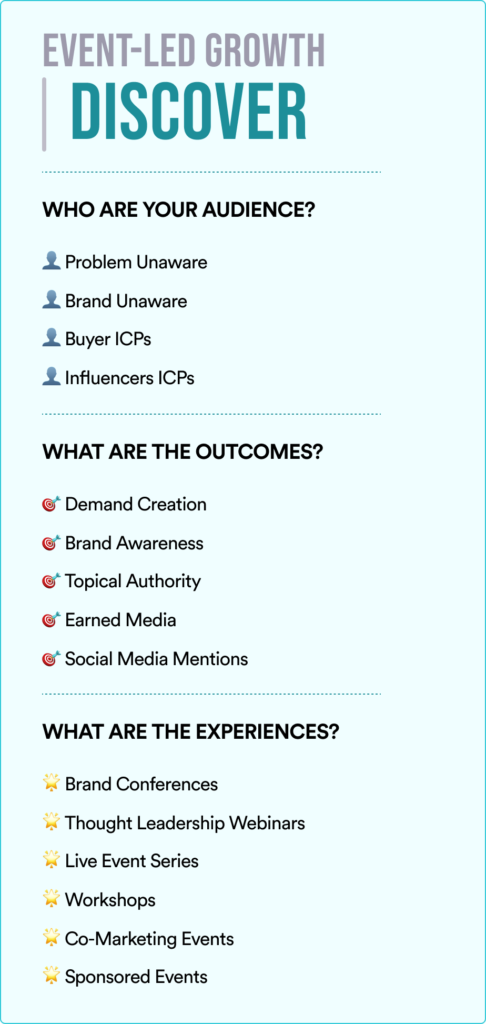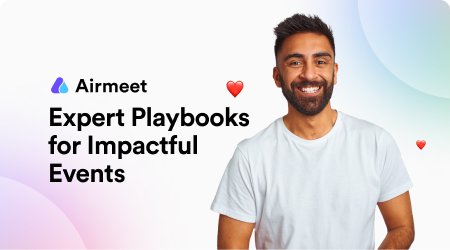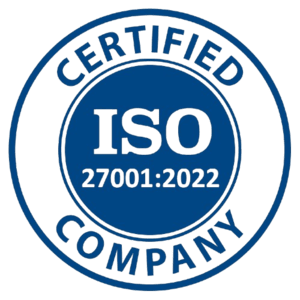Brand-focused ToFu events aren’t always at the top of the priority list to solve these kinds of problems, but with Event-led Growth you can turn prospects into lifelong customers all year long. Reframing your understanding of what events can do for you can help you discover new and long-term avenues for your business.
Introducing a cold audience to your brand not through a sales call but with an intentionally-crafted experience is what will propel you forward and help you make a lasting impression—it’s the first step toward brand loyalty.
The three stages of Event-led Growth
Consider Event-led Growth as a multi-phase approach. Being able to categorize your audience and goals will help you focus your experience:
- Discover: Building brand awareness and affinity among the Problem or Brand unaware by creating valuable and memorable experiences
- Engage: Engaging buyers and warm prospects to realize the value you deliver faster and become life-long customers
- Grow: Growing affinity and advocacy among your customers and community members
No event can be 100% Discover, Engage, or Grow. Some events are designed to achieve multiple outcomes and some are smaller and hyper-focused on a single outcome. Defining the stages and tying outcomes to them can help you discern the right approach to reach that outcome.
What is the Discover stage?

The Discover stage is focused entirely on brand awareness and building affinity. It’s where you reel your audience in. They might have never heard of your brand. Or worse, they might not even be aware of the problem your product or service solves until you point it out to them in a way that resonates. How do you do that? By creating valuable and memorable experiences that offer something folks in your industry are excited to learn about.
Collecting leads and pitching to an audience who isn’t ready to buy is the old way of doing B2B marketing. Today’s audiences expect direct, personalized communication that demonstrates why they should have demand for your product or service in the first place. Treat the Discover audience as the independent, not-yet-committed potential buyers they are. This will allow them to come to you when they realize you consistently offer value.
Understanding the Discover audience
Most Discover events should ideally be targeting a cold audience, so what’s important is having a realistic understanding of why this type of audience will have an interest in your event.
Katie Brunette is the Senior Director of Global Events at Seismic, and she’s been working in the event space for over a decade. She first uncovered the power of events when working at ExactTarget. “People who’ve felt good at your events are going to stick with you. It’s so important to take care of your customers and prospects and build those experiences where they can learn and grow while also having fun.”
For her, Discover events are a great opportunity to spread awareness and provide valuable learning moments the audience can actually take away and use to improve their day-to-day.
Get it out of your head that a Discover audience is going to sign on the dotted line at the end of your event. “I think the audience's intent at this stage is just to learn and see what's out there,” says Katie. “I don't think that they are in a buying stage, they're nowhere close to being able to pull the trigger.”
And that’s why curating your audience for this event phase is crucial. “It usually all comes down to industry title and company size,” says Katie. By looking at the data available to you, a clear narrative will appear when it comes to the audience and content that will make your Discover event sing.
“I’m looking at the titles of people who are common buyers and understanding why they buy Seismic and then turning that into the content we need to attract those people.” Katie also reverse-engineers personas by taking a look at their existing best-fit customers and identifying all the problems that her organization helped to solve.
Of course, businesses of varied sizes need different considerations—SMB and enterprise customers think on different levels. “It depends on what the topic is,” says Katie. “Which means really understanding industries as well.”
Because this stage of events should not be product-specific, keep your focus on the issues your audience is likely facing, and the problems they might not even realize are holding them back from growth.
“You’re bringing people together to talk about common problems. And creating moments to be able to learn from like-minded people. For you to be the catalyst for that is really important. It’s all about the relationships that your internal teams form with your customers and prospects.” At this stage, your audience doesn’t need to be ready to buy at the end of the event—so long as they’re compelled to keep the conversation going.
Knowing what outcomes to measure
If the Discover stage event’s goal isn’t direct sales or even MQLs, what is it then? If you’re working towards long-term outcomes like brand awareness, demand creation, and organic word-of-mouth, you should add a Discover flavor to your event.
While some of these outcomes are more difficult to measure than more common KPIs, they still demonstrate the important impact that your event has on the business. Generating an air of topical authority will lead to better speakers for future events, the creation of demand will guide people further down the pipeline, and earned media is a cost-effective way to promote your brand.
Packaging matters: Deliver the right experience
Once you’ve determined your ideal outcomes, your event types and the experiences they’re made of should serve those goals. Experiment with formats, duration, and frequencies and see what works.
In the discovery phase, you've gotta keep it short—45 minutes to an hour max. Repeatability can become your biggest ally, think of something like a webinar series that they can sign up for at the beginning that has relative topics throughout. You're not going to get somebody in the discovery phase to sign on for a three or four-hour virtual conference unless you have something super compelling going on.
Katie Brunette, Senior Director of Global Events, Seismic Tweet
Don’t forget: Creating a valuable, memorable experience for this type of audience should be at the top of your checklist. Your attendees should leave or log off your event having learned something and been delighted in some way, and you should have created a demand for your product, eventually.
Increasing downstream impact
So if your audience is inherently not yet interested in making a purchase, and if your event type leans more towards providing a valuable experience rather than selling your product, what does the attendee’s journey to becoming a customer look like?
To understand this, you need to first understand Event-led Growth. A Discover event—or any event—is no longer simply a one-and-done activity. Events should be a continuous conversation, which means that engagement throughout the event lifecycle is a key factor in keeping an attendee interested. You could be hooking people mid-event with exclusive access and additional resources. This will play a role in enhancing their affinity towards your brand.
The beauty of modern events is in their built-in long tail: you can share the event recordings or get even more creative with enhanced packaging, and keep the lines of communication open to see who wants to learn more. Provide more value before offering a demo to give the relationship a more solid foundation to build on.
You can also consider flipping some best practices—not sending gifts before the event to pique interest, but sending them after as a surprise that keeps the memories fresh in their minds and makes them more likely to respond to your follow-up. The ultimate goal here is to make these people a part of your community. It’s all about offering value and space and opportunities—help them want to be involved with your brand.
Who’s doing these events?
Looking for inspiration for your own Discover event? Look no further than Agorapulse. This social media management software company hosts their annual Agency Summits for their primary clientele, agencies. Here’s how they do it:
Event type: Networking and content-delivery summit
Experiences: Live workshops, Q+A with industry influencers, breakout sessions, speakers, brand partners, and vendor booths
Goals: Candid conversations and connections that provide value
Price: Free
Why does Agorapulse do these events every year? Because they work. While the content is topical and relevant, it’s the connections and conversations outside the scheduled sessions that provide the most impactful experiences for attendees. These moments make the Summit a must-attend event that others in the industry are interested to try simply because their peers are sharing their positive experiences.
Why you should run your own Discover events
The Discover phase of events has so much potential to set you up for future success—turning cold audience members into prospects is the lifeblood of your funnel, but doing it authentically matters. Narrowing in on a pressing topic close to your industry, inviting an audience who is primed to learn about your brand, and delivering an experience that is both memorable and valuable are the key factors to moving this audience segment to the next phase.
How you gain and, more importantly, keep their attention can be your biggest differentiator.



























